FLAIR技术推测急性缺血性卒中发作时间的临床研究
杨俊峰 李月春 王宝军 姜长春 崇奕 刘洪勇 索志强
FLAIR技术推测急性缺血性卒中发作时间的临床研究
杨俊峰*李月春*王宝军*姜长春*崇奕*刘洪勇*索志强*
目的通过对已知发病时间急性缺血性脑卒中(acute ischemic stroke,AIS)患者的头颅影像学中液体衰减反转恢复(fluid-attenuated inversion-recovery,FLAIR)序列及相应感兴趣区(volume of interest,ROI)信号强度的分析,研究是否可推测未知发病时间的AIS首次症状发作时间,是否能对溶栓治疗有一定的指导作用。方法选择2011年1月到2012年12月包头中心医院神经内科住院的AIS患者,首次症状发生在12 h内,并行核磁共振成像(magnetic resonance imaging,MRI)、磁共振弥散加权成像(diffusion-weighted imaging,DWI)、表观弥散系数(apparent diffusion coefficient,ADC)、FLAIR检查,确诊为AIS的47例符合入组条件的患者,分为≤180 min、>180 min≤360 min、>360 min≤720 min三组,测量每一例患者病灶的DWI、FLAIR、ADC及对侧rDWI、rFLAIR、rADC相应感兴趣区(region of interest,ROI)信号强度值,两两比较三组的FLAIR信号强度,并计算FLAIR阳性组、FLAIR阴性组的比率,进行统计学分析。结果三组病例的FLAIR信号强度值两两比较P=0.038,存在显著性差异;“≤180 min”和“>180 min≤360 min”的FLAIR值均显著低于“>360 min≤720 min”;≤180 min FLAIR阳性率16.7%,>180 min≤360 min阳性率62.5%,>360 min≤720 min阳性率70.6%。结论 本研究共入组47例患者,其中≤180 min 6例、>180 min≤360 min 24例、>360 min≤720 min 17例;随着发病时间延长,FLAIR的阳性率逐渐增高;反之,FLAIR阳性率越低表明AIS发病时间越短,对急性期静脉溶栓治疗具有重要的指导作用。
FLAIR 急性缺血性卒中 发作时间
我国缺血性脑卒中(ischemic stroke IS)占脑卒中的43%~79%,然而,对于急性脑梗死溶栓治疗率仅2%[1]。不论是静脉溶栓、还是动脉溶栓,选择合适的溶栓时机至关重要;能不能进行溶栓治疗“时间窗[2-3]”是关键因素,有很多缺血性卒中的患者在夜间睡眠中发病或因失语、意识模糊,不能提供准确发病时间,给溶栓治疗“时间窗”的判断带来困难[4]。核磁共振成像能精确定位急性脑梗塞的部位、性质、程度及帮助选择临床治疗方案[5-6]。
目前核磁共振成像在AIS的应用中,DWI对病变更为敏感,病变与正常组织间的对比度更高,其所显示的异常信号范围均不同程度大于常规T2加权成像(T2WI)和FLAIR。但DWI的空间分辨率相对较低,不能确切判断脑梗死的发病时间;因此,DWI不能对一些未知具体发病时间的急性脑梗死患者是否符合时间窗、是否能行溶栓治疗做出判断;然而FLAIR技术对脑组织缺血的灵敏度更高[7-9],对ADC值及信号强度没有显著影响,对颅底部(如颞极、额叶底部、小脑)病变显示则较DWI更清晰[10-12]。近些年来,国外大量的文献报道FLAIR技术可确定发病时间不明确的IS患者的发病时间[13-16]。
1 资料与方法
1.1研究对象本研究选择2011年1月到2012年12月包头市中心医院神经内科住院的急性缺血性脑卒中患者。入组标准:①年龄:40岁~80岁;②发病在12 h内,首次行核磁共振检查时间在入院1 h内完成;③DWI成像病灶已显影的脑梗死患者。排除标准:①核磁证实有颅内出血、肿瘤、颅内感染、变性病及其他脑梗死之外的疾病;②安装有心脏起搏器、血管内支架、金色义齿等不能完成核磁共振检查的患者;③DWI成像病灶直径小于15 mm的患者;④病灶对侧相应区域有软化灶、钙化、急性梗死灶等影响测量值的患者。最后共47例患者入组,其中男30例,女17例,平均年龄(64.6±10.9)岁,平均发病时间(300.0±131.9)min,平均信号强度值(423.1±90.8)。
1.2研究方法 扫描方法:所有AIS患者入院后及时行头颅磁共振检查。采用西门子(SKYRA)3.0T超导型MRI设备检查,扫描序列:①T1WI,TR 220.0 ms,TE 248 ms,视野(FOV)230 mm;②T2WI,TR 4500 ms,TE 106.0 ms,矩阵512×512,FOV 230 mm;③ FLAIR,TR 8600 ms,TE 94.0 ms,矩阵512×512,FOV 230 mm;④DWI采用单次激发自旋回波平面序列,TR 5500 ms,TE 100 ms,矩阵256× 256,FOV 230 mm,在相互垂直的X、Y和Z轴3个方向上施加扩散梯度,取3个b值(b=0,1000,2000 s/mm2),所有扫描序列层厚5 mm,层间距1.5 mm;⑤根据b=1000 s/mm2DWI图像,由系统自带软件得出ADC图像。
图像分析:由一位神经影像学专家和一位神经病学专家分析图像,对于不确定病例协商决定。DWI阳性的定义是在b=1000 s/mm2的图像上表现为高信号,相应区域在FLAIR序列可能为高信号,也可能未显影,相应区域ADC图像表现为低信号,且位于与临床症状相关的血管供血区。以此为依据将DWI阳性者入组,根据发病时间分为三组。对于DWI高信号区域中心部位选择小圆形感兴趣区(ROI),通过系统自带的德国(toolAnToNIa)工具测量ROI信号强度,ROI镜像至对侧大脑半球相应区域(ROI’),测量其信号强度值;同理测量ADC、FLAIR相应的ROI信号值及对侧rFLAIR、rADC的ROI’信号值;计算FLAIR比率(RSI)=FLAIR的ROI信号值/对侧相应ROI’信号值;对符合入组标准的DWI上多个病灶、取最大者。如图1、图2所示。
1.3统计学方法 应用SPSS 17.0进行统计分析,FLAIR阳性组与FLAIR阴性组一般情况比较:年龄,性别,发病时间;不同时间段RSI;FLAIR+与FLAIR-比率;三组信号值比较。对称分布资料数据采用±s表示,单因素方差分析(F检验),偏态分布资料数据采用中位数表示,计量资料组间比较采用成组t检验,计数资料比较采用Fisher确切概率法,检验水准α=0.05。
2 结果
2.1FLAIR阳性组、FLAIR阴性组一般情况 如表1所示,共入选47例患者,其中≤180 min 6例、>180 min≤360 min 24例、>360 min≤720 min 17例;FLAIR阳性患者28例,FLAIR阳性组平均年龄(65.1±9.2)岁,性别比例(男/女)16/12,平均发病时间(372.5±119.9)min,平均信号强度值(486.5±123.0);FLAIR阴性组19例,性别比例(男/女)14/5,平均年龄(64.6±10.9)岁,平均发病时间(300.0±131.9)min,平均信号强度值423.1±90.8,两组间年龄、性别、信号值无统计学差异。发病时间存在统计学差异。
2.2三组患者ROI信号强度值比较 三组患者,≤180 min:DWI信号值(310.0±96.3),FLAIR信号值(381.4±86.1),ADC值(456.7±102.1),RSI(1.1± 0.1);>180 min≤360 min:DWI信号值(295.6± 86.5),FLAIR信号值(428.5±79.4),ADC值(441.9±99.9),RSI(1.2±0.1);>360 min≤720 min:DWI信号值(303.0±87.91),FLAIR信号值(547.4±84.6),ADC值(405.3±92.4),RSI(1.6± 0.1);。三组中DWI、ADC、RSI比较,无统计学差异;而FLAIR组有显著统计学差异(P=0.038),三组两两比较,“≤180 min”和“>180 min≤360 min”的FLAIR值均显著低于“>360 min≤720 min”,说明在0~720 min内,随着时间的增加、信号强度逐渐增高(见表2)。

图2 DWI、FLAIR、ADC图 每幅图上都标有病灶ROI及对侧投射区ROI’的信号强度值
2.3FLAIR+与FLAIR-的特点如图3所示,≤180 min共6例,FLAIR阴性(FLAIR-)5例,FLAIR阳性(FLAIR+)1例,阳性率16.7%;>180 min≤360 min共24例,FLAIR阴性(FLAIR-)9例,FLAIR阳性(FLAIR+)15例,阳性率62.5%;>360min≤ 720 min共17例,FLAIR阴性(FLAIR-)5例,FLAIR阳性(FLAIR+)12例,阳性率70.6%;表明FLAIR阳性率逐渐升高;从图4可以看出FLAIR+信号值随时间演变逐渐增强,而FLAIR-无明显变化。

图3 FLAIR+、FLAIR-比率
2.4RSI与时间变化的关系 从图5可以看出,RSI值随时间延长逐渐增强;同时可以看出RSI值主要分布在180~480 min之间,表明180 min之后RSI逐渐增加,FLAIR与rFLAIR信号值的比率逐渐增大。

表1 FLAIR阳性组、FLAIR阴性组一般情况比较

表2 三组患者ROI信号强度值比较

图4 FLAIR+与FLAIR-的线性关系 注:纵轴信号强度值;横轴发病时间(min)

图5 RSI与时间变化的关系 纵轴:RSI(FLAIR/rFLAIR信号强度比值;横轴:发病时间
3 讨论
3.1FLAIR成像基础、特点及意义 FLAIR序列是是Hajnal等[17-18]在1992年首次报道并应用于临床。FLAIR序列是一种脑脊液信号被抑制的T2加权序列,基本原理是首先使用一个180度反转脉冲,使所有组织的纵向磁化矢量反转到负方向,随后又逐渐向正方向恢复,使脑脊液在90度射频脉冲作用时其纵向磁化矢量恢复为零,转移至横向磁化矢量亦为零,不产生信号,脑脊液被抑制,消除了其产生的容积效应及运动伪影的影响,而且被抑制的脑脊液呈低或无信号,病变不被抑制,呈高信号;从而对病变的定量、定性更加准确。
3.2急性缺血性卒中DW I阳性/FLAIR阴性不匹配的分析本研究图1中看出,180 min内FLAIR阳性率仅为16.7%,而180~360 min FLAIR阳性率为62.5%,360~720 min FLAIR阳性率为70.5%,表明DWI阳性/FLAIR阴性不匹配性随时间延长FLAIR的阴性率越来越小,而不匹配性逐渐增大,提示我们不匹配性越大发病时间越长,此结果与Thomalla[19]的研究基本一致。Gtz Thomalla等[20]的一项多中心观察研究认为DWI阳性/FLAIR阴性不匹配可以预测发病在4.5 h的急性缺血性卒中的发病时间;还有多项研究认为DWI阳性/FLAIR阴性不匹配是估计未知发病时间的IS患者的发病时间的最佳方法[7,15-16]。而Ebinger等[21]对94例发病12 h内的患者进行相关研究,认为FLAIR与发病时间没有显著相关性(R:0.15,P=0.128),不能估计脑卒中症状发生在4.5 h内的患者的发病时间。这些差异的原因可能是每个研究中入选患者数及研究方案不同所致。因此,从本研究中我们可以推测DWI阳性/FLAIR阴性不匹配性越小,AIS的发病时间越短,从而患者能接受溶栓治疗机会就越高。
3.3FLAIR信号强度值与急性缺血性卒中的关系急性缺血性卒中的治疗方案是根据症状发作的时间所决定的;但是,多达25%的患者卒中发作在睡眠时,不能确定发病时间[22-23],因此醒来时已超出了国际溶栓治疗的准则[24]。而FLAIR成像信号强度的演变在AIS中,作为一个潜在的卒中发作时间标记的替代指标已经吸引了越来越多的关注。本研究中图2可以看出FLAIR信号强度值随时间延长逐渐增加、rFLAIR信号强度值变化不明显;表1中FLAIR平均信号强度值(486.5±123.0)、明显高于rFLAIR平均信号强度值(423.1±90.8);Bastian Cheng等[4]已经提出了定量测定FLAIR相对信号的强度(RSI)来预测急性缺血性卒中的时间,认为FLAIR RSI值可以作为AIS发病时间的一个替代标记。本研究同样对FLAIR RSI值做了统计学分析,图3可以看出RSI强度值随时间延长逐渐增强;同时RSI值主要分布在180~480 min之间,表明180 min之后FLAIR信号值明显高于rFLAIR;本研究表2中表明三组FLAIR强度信号值两两比较具有明显统计学差异(P=0.038),但因样本量小未能得出三组RSI具有统计学差异(P= 0.181)。
综上所述,对于未知发病时间的AIS患者,尽快行头颅核磁检查,我们通过对DWI、FLAIR成像的分析,如DWI成像已显示病灶、而FLAIR像未显影,我们可以初步判断发病时间在12 h内,再通过对FLAIR信号强度的测定就可以进一步推测AIS的发病时间,对AIS患者是否可行溶栓治疗具有极为重要的意义。但目前仍无统一的标准及定论;我们还需通过大样本、多中心的研究进一步探讨FLAIR在AIS中的临床应用价值。
[1]Kleindorfer D,Lindsell CJ,Brass L,et al.National US estimates of recombinant tissue plasminogen activator use:ICD-9 codes substantially underestimate[J].Stroke,2008,39(4): 924-928.
[2]Guidelines for management of ischaemic stroke and transient ischaemic attack 2008[J].Cerebrovasc Dis,2008,25(6): 457-507.
[3]Adams HP Jr,del Zoppo G,Alberts MJ,et al.Guidelines for the early management of adults with ischemic stroke:a guideline from the American Heart Association/American Stroke Association Stroke Council,Clinical Cardiology Council,Cardiovascular Radiology and Intervention Council,and the Atherosclerotic Peripheral Vascular Disease and Quality of Care Outcomes in Research Interdisciplinary Working Groups:the American Academy of Neurology affirms the value of this guideline as an educational tool for neurologists[J].Stroke,2007,38(3):1655-1711.
[4]Bastian Cheng,Mathias Brinkmann1,Nils D Forkert,et al. Quantitative measurements of relative uid-attenuated inversion recovery(FLAIR)signal intensities in acute stroke for the prediction of time from symptom onset[J].Journal of Cerebral Blood Flow&Metabolism,2013,33(10):76-84.
[5]Richard E.Burgess,Chelsea S.Kidwell.Use of MRI in the Assessment of Patients with Stroke[J].Curr Neurol Neurosci Rep 2011,11(2):28-34.
[6]潘经锐,袁芳,黄小雄,等.功能磁共振成像对急性脑梗死患者预后判断的价值[J].中国神经精神疾病杂志,2012,38(10):577-581.
[7]Thomalla G,Rossbach P,Rosenkranz M,et al.Negative fl uid-attenuated inversion recoveryimaging identifi es acute ischemic stroke at 3hours or less[J].Ann Neurol 2009,65(6): 724-732.
[8]Perkins CJ,Kahya E,Roque CT,et al.Fluid-attenuated inversion recoveryand diffusion and perfusion-weighted MRI abnormalities in 117 consecutive patientswith stroke symptoms[J]. Stroke,2001,32(12):2774-2781.
[9]Gauvrit JY,Leclerc X,Girot M,et al.Fluidattenuatedinversion recovery(FLAIR)sequencesfor the assessment of acute stroke:inter observer and inter technique reproducibility[J].J Neurol,2006,253(5):631-635.
[10]Maeda M,Yamamoto T,Daimon S,et al.Arterial hyperintensity on fastfl uid-attenuated inversion recovery images:asubtle fi nding for hyperacute stroke undetectedby diffusion-weighted MRimag ing[J].AJNRAm J Neuroradiol,2001,22 (4): 632-636.
[11]Kamran S,Bates V,Bakshi R,et al.Signifi cance of hyperintensevessels on FLAIR MRI in acutestroke[J].Neurology,2000,55(2):265-269.
[12]Toyoda K,Ida M,Fukuda K.Fluid-attenuatedinversion recov-ery intraarterial signal:an earlysign of hyperacute cerebral ischemia[J].AJNRAm J Neuroradiol,2001,22(6):1021-1029.
[13]Thomalla G,Rossbach P,Rosenkranz M,et al.Negative Fluid-Attenuated inversion recovery imaging identies acute ischemic stroke at 3 hours or less[J].Ann Neurol,2009,65(6): 724-732.
[14]Noguchi K,Ogawa T,Inugami A,et al.MRI of acute cerebral infarction:acomparisonof FLAIRandT2-weightedfast spin-echo imaging[J].Neuroradiology,1997,39(6):406-410.
[15]Aoki J,Kimura K,Iquchi Y,et al.Intravenous thrombolysis based on diffusion-weighted imaging and fluid-attenuated inversion recovery mismatch in acute stroke patients with unknown onset time[J].Cerebrovasc Dis,2011,31(5):435-441.
[16]Petkova M,Rodrigo S,Lamy C,et al.MR imaging helps predict time from symptom onset in patients with acute stroke:Implications for patients with unknown onset time[J].Radiology,2010,257(3):782-792.
[17]Hajanl JV,Bryant DJ,Kasuboski L,et al.Use of fluid-attenuate inversion recovery(FLAIR)pulse sequences in MR of the brain[J].Comput Assis Tomogr,1992,16(3):841.
[18]董晓宇,翟志永,佡剑非.FLAIR血管高信号在颈动脉系统短暂性脑缺血发作的意义及相关因素分析[J].中国神经精神疾病杂志,2015,41(8):449-454.
[19]Thomalla G,Cheng B,Ebinger M,et al.DWI-FLAIR mismatch for the identification of patients with acute ischaemic stroke within 4.5 h of symptom onset(PRE-FLAIR):a multicentre observational study[J].Lancet Neurol,2011,10(11):978-986.
[20]Gtz T,Bastian C,Martin E,et al.DWI-FLAIR mismatch for the identication of patients with acute ischaemic stroke within 4.5 h of symptom onset[J].Lancet Neurol,2011,10(3):978-986. Martin E,Ivana G,Michal R,et al.Fluid-Attenuated Inversion
[21]Recovery Evolution Within 12 Hours From Stroke Onset:a reliable tissue clock[J].Stroke,2010,41(2):250-255.
[22]Omama S,Yoshida Y,Ogawa A,et al.Differences in circadian variation of cerebral infarction,intracerebral haemorrhage and subarachnoid haemorrhage by situation at onset[J].J Neurol Neurosurg Psychiatry,2006,77(12):1345-1349.
[23]Serena J,Davalos A,Segura T,et al.Stroke on awakening:looking for a more rational management[J].Cerebrovasc Dis,2003,16(4):128-133.
[24]Fink JN,Kumar S,Horkan C,et al.The stroke patient who woke up:clinical and radiological features,including diffusion and perfusion MRI[J].Stroke,2002,33(8):988-993.
The study on estimation of the onset time by fluid-attenuated inversion recovery in acute ischem ic stroke.
YANG Junfeng,LI Yuechun,WANG Baojun,JIANG Changchun,CHONG Yi,LIU Hongyong,SUO Zhiqiang.Department of Neurology,Baotou City Central Hospital,Baotou 014040,China.Tel:0472-6917979.
Objective To explore whether fluid-attenuated inversion recovery can be used to estimate the onset time of acute ischemic stroke(ALS)based on the analysis of signal strength through the fluid-attenuated inversion-recovery(FLAIR)and volume of interest(ROI)in ALS patients with known time of onset.M ethod Forty-seven AIS patients who met the inclusion criteria were recruited from Baotou Central Hospital,Department of Neurology from January 2011 to December 2012.The patients had stroke onset within 12 hours and completed MRI scan including diffusion-weighted imaging DWI,apparent diffusion and coefficient ADC FLAIR.Based on MRI findings,patients were divided into,three groups:0~180 min,180~360 min and 360~720 min groups.Signal strength values of the DWI、FLAIR and ADC in ipsilateral and contralateral sides were measured.Result There was a significant difference in the FLAIR signal strength among these three groups.The FLAIR signal strength was significantly lower in 0~180 min and 180~360 min groups thanin 360-720 min.FLAIR positive rate was 16.7%,62.5%,and 70.6%in 0~180 min,180~360 min and 360~729 min groups,respectively.Conclusion FLAIR positive rate gradually increases as the onset prolongs.Thus,lower FLAIR positive rate indicates shorter onset time of AIS,which can be used to assist acute intravenous thrombolytic therapy.
FLAIR Acute Ischemic Stroke The onset time
R743.3
A
2015-06-12)
(责任编辑:李立)
10.3969/j.issn.1002-0152.2015.12.006
*内蒙古包头市中心医院神经内科(包头014040)

